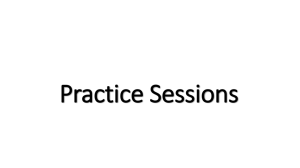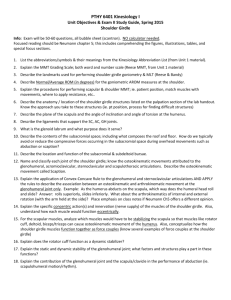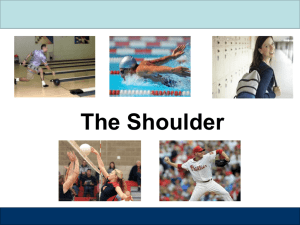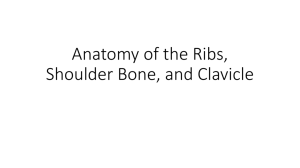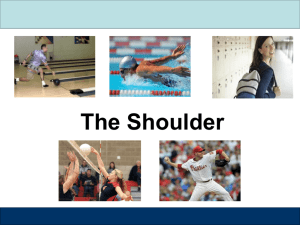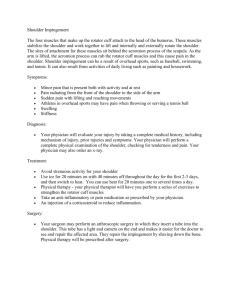The Shoulder Girdle
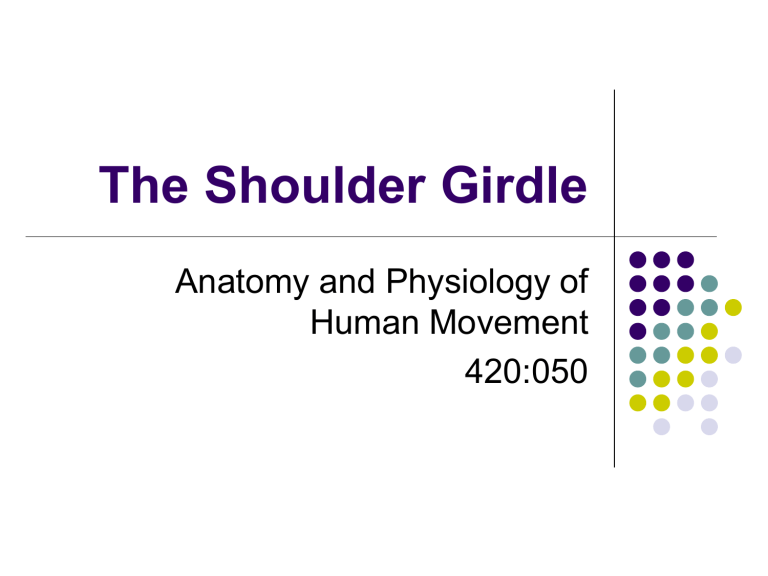
The Shoulder Girdle
Anatomy and Physiology of
Human Movement
420:050
Objectives
Bones, bony landmarks and joints
Muscles
Movements
The Shoulder Girdle
The scapula and clavicle
Two joints
Functions
Dynamic stability
Increased ROM
From Seeley RR, Stephens TD, Tate P; anatomy and physiology , ed 7, New York, 2006, McGraw-Hill
From Seeley RR, Stephens TD, Tate P; anatomy and physiology , ed 7, New York, 2006, McGraw-Hill
Joints
Shoulder girdle (scapulothoracic)
Scapula moves on the rib cage
Joint motion occurs at sternoclavicular joint & to a lesser amount at the acromioclavicular joint
Joints
Sternoclavicular (SC)
(Multiaxial) arthrodial/gliding classification
Movements
Anteriorly with protraction
Posteriorly with retraction
Superiorly with elevation
Inferiorly with depression
Joints
Acromioclavicular (AC)
Arthrodial/gliding classification
Movements
Some gliding & rotational motion accompanying other shoulder girdle & shoulder joint motions
Often injured
Objectives
Bones, bony landmarks and joints
Muscles
Movements
Muscles
Five muscles primarily involved in shoulder girdle movements
All originate on axial skeleton & insert on scapula and/or clavicle
Do not attach to humerus & do not cause shoulder joint actions
Functions:
Stability
ROM of shoulder joint
Shoulder Girdle Muscles
Five muscles primarily involved in shoulder girdle movements
Trapezius - upper, middle, lower
Rhomboid - deep
Levator scapula
Serratus anterior
Pectoralis minor - deep
Trapezius
Levator Scapulae
Rhomboids
Serratus Anterior
Pectoralis Minor
Subclavius
Objectives
Bones, bony landmarks and joints
Muscles
Movements
Movements
Focus on specific bony landmarks
inferior angle glenoid fossa acromion process
Shoulder girdle movements = scapula movements
Movements
Elevation
upward or superior movement, as in shrugging shoulders
Depression
downward or inferior movement, as in returning to normal position
Movements
Abduction (protraction)
scapula moves laterally away from spinal column
Adduction (retraction)
scapula moves medially toward spinal column
Movements
Upward rotation
turning glenoid fossa upward
& moving inferior angle superolaterally away from spinal column
Downward rotation
returning inferior angle inferomedially toward spinal column & glenoid fossa to normal position
Shoulder
Girdle
Movements
Adduction
Elevation
Abduction
Depression
Movements
Anterior tilt (upward tilt)
Rotational movement of scapula about frontal axis
Occurs during glenohumeral hyperextension
Posterior tilt (downward tilt)
Rotational movement of scapula about frontal axis
Occurs during glenohumeral hyperflexion
Movements
Lateral tilt (outward tilt)
Rotational movement about its vertical axis
Occurs during protraction
Medial tilt (return from lateral tilt, inward tilt)
Rotational movement about its vertical axis
Occurs during retraction
Movements
Shoulder joint & shoulder girdle work together
Shoulder girdle movement independent
Upward/downward rotation?
Shoulder girdle muscles
Stabilize scapula
Enhance ROM of shoulder joint
ELEVATION
Proximal attachment:
Above or below scapula/clavicle?
How many muscles fit this criteria?
Upper fibers trapezius
Middle fibers trapezius
Rhomboids
Levator Scapulae
DEPRESSION
Proximal attachment:
Above or below scapula/clavicle?
How many muscles fit this criteria?
Lower fibers trapezius
Pectoralis minor
Subclavius
RETRACTION
Proximal attachment: In front (ribs) or behind
(spine)?
How many muscles fit this criteria?
Trapezius (all fibers)
Rhomboids
Levator scapulae
PROTRACTION
Proximal attachment: In front (ribs) or behind
(spine)?
How many muscles fit this criteria?
Serratus anterior
Pectoralis minor
UPWARD ROTATION
Upward or downward torque?
How many muscles fit this criteria?
Trapezius (all fibers)
Serratus anterior
DOWNWARD ROTATION
Upward or downward torque?
How many muscles fit this criteria?
Pectoralis minor
Rhomboids
